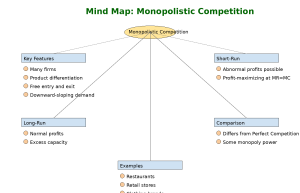24 Jul Monopolistic Competition
Monopolistic Competition – UPSC Economics Optional Notes
Introduction
Monopolistic competition is a realistic market structure that combines elements of both perfect competition and monopoly. It is widely applicable to many real-world industries, particularly in the service and retail sectors. In the context of the UPSC Civil Services Examination (CSE), especially for those choosing Economics as their optional subject, understanding the theory of monopolistic competition is crucial for both Paper 1 and Paper 2 applications.
Definition of Monopolistic Competition
Monopolistic competition refers to a market structure where a large number of firms compete with differentiated products. While each firm enjoys some monopoly power, the market also remains competitive due to free entry and exit and a large number of sellers.
Definition by E.H. Chamberlin:
“Monopolistic competition is a market situation in which a large number of producers sell products that are differentiated from one another.”
Key Features of Monopolistic Competition
- Many Firms: A large number of small sellers, none having a dominant market share.
- Product Differentiation: Each firm offers a product slightly different from its competitors (e.g., branding, quality, packaging).
- Freedom of Entry and Exit: No significant barriers to entry or exit, especially in the long run.
- Downward Sloping Demand Curve: Because of product differentiation, each firm faces its own demand curve.
- Non-price Competition: Firms compete through advertising, brand image, and customer loyalty instead of price alone.
Price and Output Determination
Short-run Equilibrium:
In the short run, a firm may earn supernormal profits or incur losses, depending on the demand and cost conditions. The firm maximizes profit where MR = MC, and the price is determined by the corresponding point on the AR (demand) curve.
Long-run Equilibrium:
In the long run, entry of new firms erodes any abnormal profits. The firm reaches equilibrium where it earns only normal profits. Price equals average cost (P = AC), but not at the minimum point of AC, resulting in excess capacity.
Diagram: Monopolistic Competition
Short Run: Firms can earn supernormal profits as AR > AC.
Long Run: Entry of new firms leads to only normal profits; AR = AC but not at minimum AC.
(Insert diagram in your WordPress media library showing AR, MR, AC, and MC curves intersecting)
Comparison with Other Market Forms
| Feature | Perfect Competition | Monopolistic Competition | Monopoly |
|---|---|---|---|
| Number of Sellers | Many | Many | One |
| Product Type | Homogeneous | Differentiated | Unique |
| Entry/Exit | Free | Free | Restricted |
| Price Maker? | No | Yes (limited) | Yes |
| Profit (Long Run) | Normal | Normal | Abnormal |
Efficiency and Welfare Implications
- Allocative Inefficiency: Price exceeds marginal cost (P > MC).
- Productive Inefficiency: Firms do not operate at the lowest point on the AC curve.
- Excess Capacity: Firms underutilize capacity, leading to wastage of resources.
Real-life Examples
- Retail shops
- Restaurants and fast food chains
- Beauty salons
- Clothing brands (e.g., Zara, H&M)
- Toothpaste brands (e.g., Colgate vs. Pepsodent)
Infographic

Monopolistic_Competition_Infographic
Mind Map

Monopolistic Competition_MindMap
Previous Year UPSC Questions
- UPSC 2022: Distinguish between monopolistic competition and perfect competition with suitable diagrams.
- UPSC 2020: How does excess capacity arise in monopolistic competition in the long run?
- UPSC 2018: Explain the concept of product differentiation and its implications for pricing in monopolistic competition.
Probable Questions for UPSC Prelims & Mains
- Mains: Examine the welfare implications of monopolistic competition.
- Mains: “In monopolistic competition, firms do not achieve productive efficiency.” Discuss with reasons.
- Prelims: Which of the following is true about monopolistic competition? (MCQ with options)
best economics optional test series
Conclusion
Monopolistic competition is a significant model in microeconomic theory, offering insights into real-world markets where perfect competition and monopoly assumptions fail. It highlights the importance of product differentiation, advertising, and consumer preferences. For UPSC aspirants, mastering this topic with diagrams, theoretical underpinnings, and contemporary relevance is essential for scoring high in both objective and subjective papers of the CSE Economics optional.




No Comments